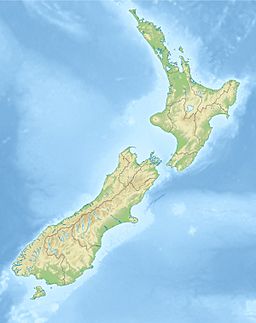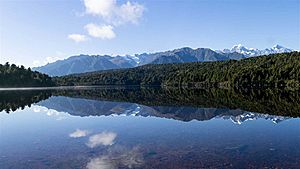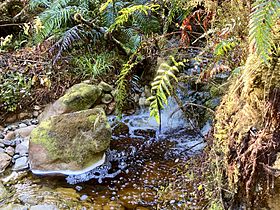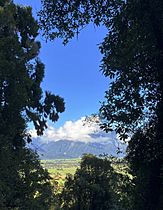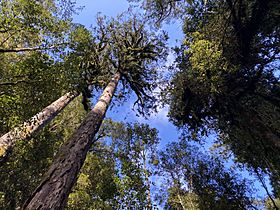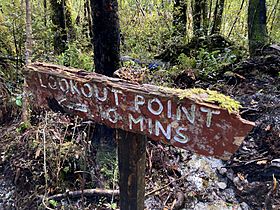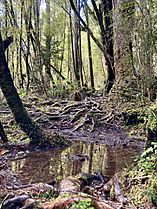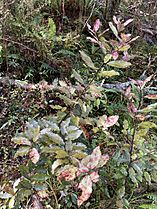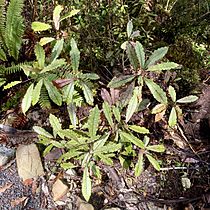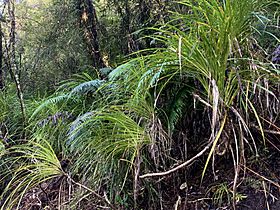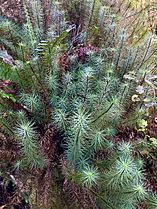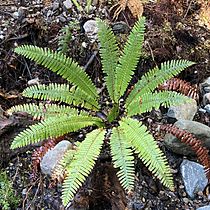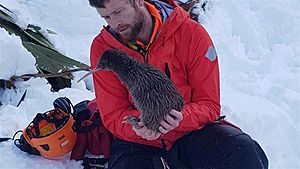Lake Gault facts for kids
Quick facts for kids Lake Gault |
|
|---|---|
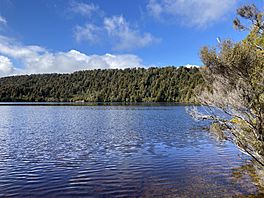 |
|
| Location | Fox Glacier, West Coast, South Island |
| Coordinates | 43°25′49″S 169°59′05″E / 43.43028°S 169.98472°E |
| Surface area | 31.8 ha (79 acres) |
| Average depth | 14.5 m (48 ft) |
| Surface elevation | 333 m (1,093 ft) |
Lake Gault is a beautiful small lake in South Westland, New Zealand. It's located close to the town of Fox Glacier. You can reach it by following a walking track from Lake Matheson. The lake is surrounded by old native forest. In the past, water from Lake Gault was used to power a gold mining machine. Today, it's also a special place where rare Ōkārito kiwi (called rowi) have been released into the wild.
Contents
Discovering Lake Gault's Geography
Lake Gault sits high up at 333 m (1,093 ft) in the Omoeroa Range. It covers an area of 31.8 ha (79 acres) and is about 14.5 m (48 ft) deep on average. The only way to get there is by walking a 4-kilometre (2.5 mi) track. This track climbs about 200 metres (660 ft) from the eastern side of Lake Matheson.
This lake was formed around 16,000 years ago. Giant glaciers moved across the land, leaving behind piles of rock and dirt called moraines. These moraines created the basin where Lake Gault now sits.
Lake Gault's water flows into a special type of wetland called pakihi to the north. This wetland is part of Skiffington Swamp. From there, the water eventually reaches the Tasman Sea.
Just like nearby Lake Matheson, Lake Gault has unique water. It's called "dystrophic," which means its water is brown. This color comes from natural chemicals called tannins that leach out of the surrounding forest. The water has few nutrients and is a bit acidic. Because the water is so dark, it creates amazing reflections of the Southern Alps. You can often see Aoraki / Mount Cook and Mount Tasman perfectly mirrored on the lake's surface.
A Look into Lake Gault's History
In the 1930s, a pipeline was built from Lake Gault. This pipeline carried water over a ridge to a small hydroelectric power station. This station was located on the Cook River flats. It generated electricity to power a gold-mining machine. This machine worked the sands at Gillespies Beach, about 15 km away, until the 1940s.
Later, in 1958, a dam was built between Lake Gault and Skiffington Swamp. This dam helped to raise the lake's water level. By this time, the hydroelectric plant was providing power to the entire village of Fox Glacier.
Exploring the Lake Gault Track
The track to Lake Gault was first made in the 1930s. It was used to reach and maintain the power station's water intake. Over time, the track became overgrown and wasn't used for about 20 years.
In April 2019, the track was reopened. This was a big project that took a year. The local Fox Glacier community worked together with the Department of Conservation. Volunteers did most of the hard work to fix the overgrown path.
After a landslide damaged the road to Fox Glacier in 2019, the government invested money to improve other local attractions. The Lake Gault Track was one of them. What used to be a muddy and difficult 3-5 hour hike was transformed. By late 2020, it was fully drained and covered with gravel, making it an "easy" walk. Now, there's a lookout point and a bench by the lake. This is a perfect spot to enjoy the mountain views, especially on a calm, clear morning.
Flora and Fauna: Plants and Animals of Lake Gault
The forest around Lake Gault is home to many native trees. You'll find tall rimu, bright red Southern rātā, and kāmahi trees. Smaller plants like horopito, tawheowheo, kiekie, and hutu grow underneath. The forest floor is covered with ferns and mosses, including the giant moss Dawsonia superba.
-
Horopito (Pseudowintera colorata)
-
Kiekie (Freycinetia banksii)
-
Crown fern (Lomaria discolor)
Besides common forest birds like the New Zealand tomtit, grey warbler, and fantail, Lake Gault is a special place for the rowi. The rowi (Apteryx rowi) is New Zealand's rarest kiwi species. By the late 1990s, there were fewer than 200 rowi left in the world. They all lived in one forest near Ōkārito.
To help save them, the Department of Conservation started a program called Operation Nest Egg. This program carefully removes rowi eggs from their nests. The eggs are then incubated at the West Coast Wildlife Centre. Once hatched, the young birds are raised on an island free from predators until they are big enough to protect themselves.
When the Ōkārito Forest became too crowded for more rowi, the forest around Lake Gault was chosen as a new home. In December 2018, 27 rowi were released there. Most stayed close to where they were released. However, one adventurous kiwi traveled 12 km down the coast and inland. It even climbed high into the mountains behind Fox Glacier. A search-and-rescue team had to retrieve it from an altitude of 1250 m!


